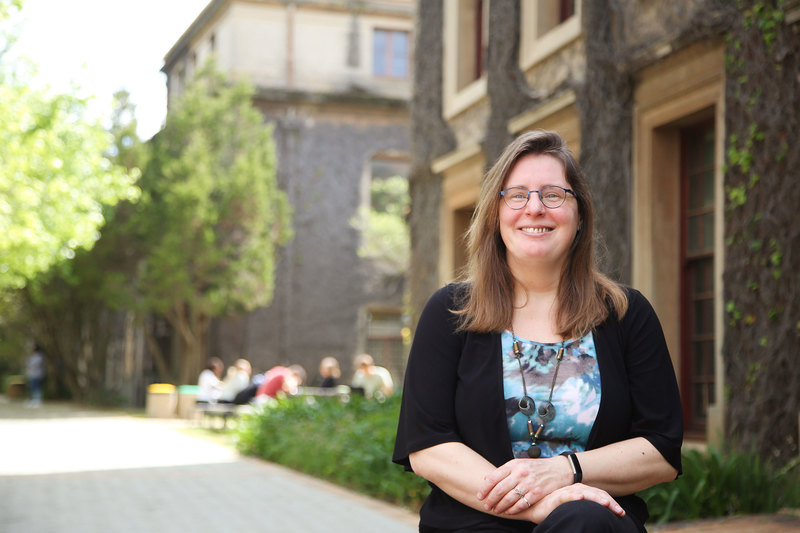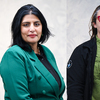Award for world-first textbook on ontological engineering
14 October 2021 | Story Helen Swingler. Photo Je’nine May. Read time 8 min.
Associate Professor Maria Keet of the Department of Computer Science has won the University of Cape Town’s (UCT) Open Textbook Award for her “exemplary resource”, An Introduction to Ontology Engineering. It is her first open textbook, and a world-first textbook on the subject for computer scientists.
The award recognises outstanding open textbooks written by UCT staff and students that advance the university’s transformation and social justice agenda.
In her congratulatory message to Associate Professor Keet, Deputy Vice-Chancellor for Teaching and Learning Associate Professor Lis Lange wrote, “The award committee was very complimentary about your work, particularly with regard to localisation, technical innovation, accessibility, and the integration of assessments and other ancillary components. Congratulations on this important, ground-breaking work.”
Keet responded to questions from UCT News.
Helen Swingler (HS): Congratulations on this award. How has the book been received? And does it have any special features?
Maria Keet (MK): As the first textbook on ontology engineering (OE) for computer scientists in the world, it is not only used at UCT but also has become a textbook of choice elsewhere in the world. As a first for computer scientists in this area, it effectively demarcates the field as well. Also, it contributes to a maturing of the research area and the science conducted within it, as it forms a basis for educating the next generation of researchers in the field.
“There’s also some guidance for reading the content for visually impaired people, particularly when it comes to logic symbols.”
It also incorporates technical and pedagogical innovations, such as software-supported exercises and several tools developed in-house to assist students to transition from the theory to hands-on engineering aspects of ontologies. It also has slides and tutorial materials, and assignment examples and solutions to selected exercises, to make it a textbook package rather than a ‘mere’ PDF.
There’s also some guidance for reading the content for visually impaired people, particularly when it comes to logic symbols.
HS: What is ontology engineering all about?
MK: OE concerns the theory, methods, techniques and tools for developing good ontologies. An ontology is an artefact that contains the classes, relations between them and their constraints holding in a particular subject domain. For instance, an ontology of human anatomy may have represented (typically in a computer-processable way) that ‘each human has as part exactly one heart’ (this is an axiom-to-text rendering), among other parts, and where they are typically located. Or, say, an ontology for universities: that they all have students who are enrolled in courses that are taught by lecturers, among other things.
Representing the subject domain precisely in a computer-processable way in an ontology can help with data integration across applications and databases, simplify search and querying databases, assist natural language processing tasks, and more. Not just in theory, but also in practice: for example, ontologies provide the theoretical underpinning for Google’s Knowledge Graph that is used to create and populate those ‘infoboxes’ you see on the right-hand side of the results page. They are hidden inside multiple end-user apps (for example, of the BBC, among many).
HS: Please give the gist of the textbook’s content.
MK: The textbook first covers the relevant logic foundations in its Part 1, introducing the logics and reasoning from mathematics first, and then narrowing these down to those logics and automated reasoning that are computationally more appealing, to a subset of those that have software tools for both the modelling and the automated reasoning.
Part 2 delves into how to get the content into the ontology in a good way. This concerns methods and methodologies to structure those activities, top-down theory informed by philosophy, and bottom-up theory by using non-ontological resources to automatically extract knowledge, to be added to the ontology. The third part contains a selection of sub-topics within OE, such as ontologies and natural language, modularisation, and ontology-based data access.
“I’d identify two challenges: creating the time to sit down and write it, and tying up all those tiny loose ends at the end to make it presentable.”
HS Tell us about its genesis and development, and the main challenges involved.
MK: It took many years. The first write-ups were blog posts, written for a module I taught in 2009 while still at the Free University of Bozen-Bolzano, Italy – part of the European Master’s in Computation Logic – that were then strung together into one story for the OE courses in Havana and Pretoria in 2010. These then became lecture notes by gradually adding more content, from 2012 to 2015; and from there came a major revision, in 2018, to culminate in a textbook that then was updated further.
I’d identify two challenges: creating the time to sit down and write it, and tying up all those tiny loose ends at the end to make it presentable, but [that] don’t improve the essential content.
HS: Who is the book aimed at?
MK: It’s aimed at an advanced level: honours and postgraduate students. It builds upon core computer science content that is normally covered to a greater or lesser extent in an undergraduate degree programme. The reason that there’s [the word] ‘Introduction’ in the title is that it does not assume the students already know something about ontologies, and topics are covered at an introductory level relative to where the state of knowledge on OE is at present. This gives students the basis to be able to read scientific literature that assumes substantial prior knowledge, and/or [to] branch out to one of the sub-fields within OE. The book is designed for a semester course, not to be a single tome for a two-year taught master’s degree in OE.
HS: Is it geared in any way to African students and their contexts?
MK: Yes, definitely. This is exhibited in the examples and tutorial material used throughout the book, which have local relevance (for example, African wildlife), and in the chapter on multilingual ontologies, where it considers African languages as well (thanks to the research I conducted with colleagues and students).
HS: What does this award mean to you, both personally and as an academic?
I appreciate the recognition for all the effort I’ve put in. In addition, open textbooks are still frowned upon by some as not really counting; or only somewhat, but [people are] unsure how and to what extent, because of uncertainty about an open textbook’s quality. Perhaps this award will help sway that opinion in my favour, [the favour] of my book. It may also nudge academics to possibly consider the open textbook route themselves.
And it will help promote the book! (A side effect of making it open, without the book-processing charges of a traditional publisher, is that one has to do any sort of marketing oneself.)
HS: Is there another one in the pipeline?
MK: There’s some cookie dough. But it would need some teaching buy-out to brush that up into a textbook. Or a sabbatical. But for my upcoming sabbatical, I’ll be focusing on catching up on research rather.
HS: Is there anything that you’d like to add?
MK: The open textbook’s development benefited from a Digital Open Textbooks for Development (DOT4D) project grant. That also meant they ‘dissected’ me along my textbook journey, as they did with all DOT4D grantees. It has also been published by the non-profit College Publications, so that people who don’t feel like doing any printing and binding themselves but want a hard copy nonetheless can buy hard copies from Amazon.
 This work is licensed under a Creative Commons Attribution-NoDerivatives 4.0 International License.
This work is licensed under a Creative Commons Attribution-NoDerivatives 4.0 International License.
Please view the republishing articles page for more information.










